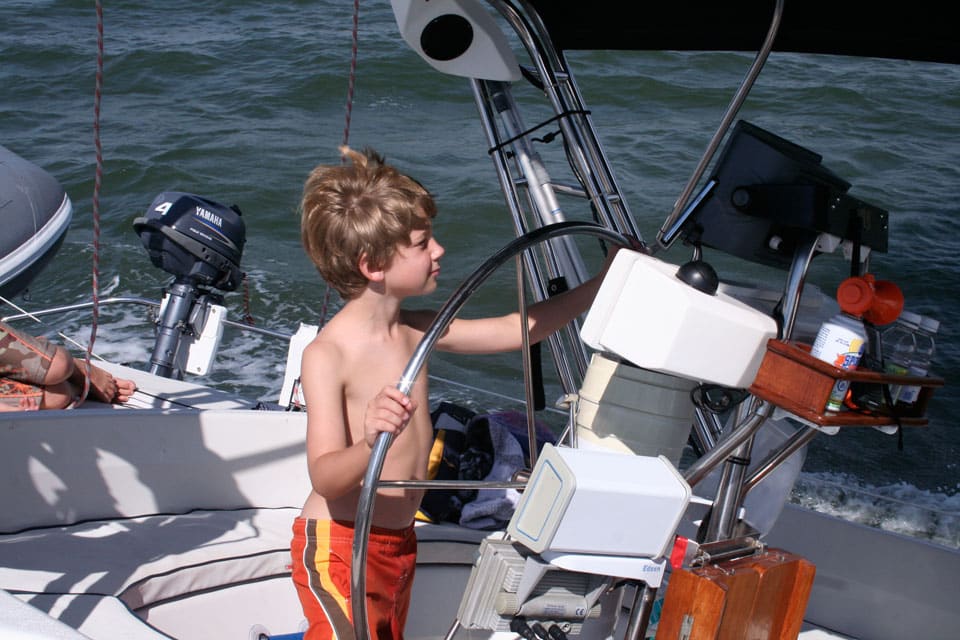
The Plan, at first, seemed perfect: Two dads and five kids enjoy a bareboat charter in southwest Florida. Five days of fun in the sun. Some real family bonding. Deep down, though, I knew The Plan would go wrong, maybe terribly wrong, and we’d have to improvise. But that’s what fathers are good at—improvising. At least that’s what I told myself 24 hours into the trip, as The Plan began to fall apart.
We were close-reaching south on the Gulf Intracoastal Waterway, just east of Gasparilla Island. To starboard, the blue-green inlet of Boca Grande Pass opened between two sandy spits, leading to the Gulf of Mexico. To port, shafts of sunlight beamed through the clouds, turning Charlotte Harbor into a Broadway stage of green shoals and brown shadows. Offering more than 200 square miles for roaming, the bay seemed ideal for a relaxing daysail with the kids, which shows how much I knew about sailing in the company of children.
We’d gotten a late start, and thunderclouds already loomed over the mainland, a fuzzy horizon of saw palmetto, mangrove, and slash pine three miles to the east. Normally, I wouldn’t sweat a summer squall, but the in-mast furling mainsail on our Hunter Passage 42 was refusing to furl. I was considering our options for shortening sail when my 8-year-old son, Ben, popped out of the companionway clutching his nose with both hands. Blood dripped through his fingers.
“I don’t know what happened. My nose just started bleeding.” He pinched his nose and lurched toward the stern rail to avoid staining the deck. When he leaned over the rail, his only pair of eyeglasses disappeared in our wake.
“Crap! I mean darn! Sorry, Dad.” He looked blindly in my direction, his world suddenly a blur.
Just then, my 6-year-old son, Jake, appeared through the companionway. “Dad, can you help me find my Pokémon cards?” Pokémon cards, as Jake will gladly explain, are like baseball trading cards, except the heroes depicted on each card are Japanese animé monsters with names like Giratina and Pikachu. Like most everything else in our household, the cards are forever getting lost.
“You’re on your own, buddy,” I told him. “The wind is picking up.” He looked at the sky and ducked back below before I could ask him for help.
I thought of asking the two 12-year-old girls in our crew, Isabella and her friend Kaylee, to help treat Ben’s nose. The two were lounging on the foredeck, comparing Glossy Bands, colorful bracelets they’d made the day before. They smiled and spoke to each other in a bubbly language that I, having no girls of my own, had no hope of understanding.
Jon Lemole, Isabella’s father, could have translated, but I didn’t dare ask. He was grunting over the Lewmar self-tailing winch that handled the mainsail furling line. He had a stranglehold on the winch handle, and the muscles on the back of his neck were a nest of rubber bands pulled taught, about to snap.
So. I turned to Evan, Jon’s 10-year-old son, who sat beside me in the cockpit. “Evan, could you go below and get some toilet paper for Ben?” Still groggy from lack of sleep, Evan was sitting like Buddha on the cockpit coaming and staring west, as if silently blessing the fleet of small fishing boats in the pass. Oblivious to the thunderclouds, Ben’s bleeding nose, or his father’s cage fight with a two-speed winch, he turned and looked at me curiously, as if I’d just asked him to paint the moon.
“How deep is the water up ahead, Mr. Nicholson?” he asked. “It looks pretty shallow to me.”
And all this time, the cockpit speakers were cheerfully booming Jimmy Buffett: “Boat drinks, boys in the band ordered boat drinks.”
As if the heavens couldn’t bear another Florida family-vacation meltdown, our worries disappeared as quickly as they’d come. The squall took a compassionate bend to the north, leaving white, puffy clouds overhead. Finesse and forearm strength cured the mast furler, a cottonball stemmed Ben’s bleeding, and Jake’s Pokémon cards materialized in his duffel bag. Ben tried out my reading glasses and stopped bumping into bulkheads. No gear was broken, no harsh words were exchanged, and there was no need to break the seal on the Flor de Caña rum stashed under the galley sink. Although not quite the Jimmy Buffett ideal, life was good again.
I passed Jon the helm and kicked back in the cockpit. As we reached toward the island of Cayo Costa, the waterway’s red and green markers aligned like highway signs, aiming toward a cloud that bore a striking resemblance to a young Bob Dylan—in his wild-hair days of Blonde on Blonde.
“Check out that one, Dad,” Jake said, pointing at the cloud. “It looks just like Pikachu.”
This was going to be fun.
The Healing Feeling
My wife, Theresa, and I have a saying about cruising: “It’s not a cruise until someone is bleeding.” We picked it up years ago while sailing the South Pacific in an old wooden boat, when it seemed that each new voyage to paradise began with a stubbed toe and a stream of obscenities yelled at the sky. So we adjusted. We kept a box of Band-Aids by the companionway and told ourselves that blood on the non-skid was a fair price for the passage. Cruising—bruises, torn sails, storms, and all—was our therapy. Sailing gave us strength, taught us patience, and kept us sane. It was this belief in the healing powers of time on the water that sparked my idea of a kids-and-dads cruise.
One year earlier, Jon’s wife, Rita, had died of cancer, at the age of 39. A beloved fitness trainer in our hometown of Sarasota, Florida, she was my wife’s close friend. Her sudden passing left a hole in too many lives—“Even the angels are crying,” Jake explained to me, when it rained on the day of her funeral—and too little time for grieving. Our world, our cozy little ship, had been rolled, dismasted, and left to drift.
As Jon juggled work and the duties of single-parenthood, friends and neighbors chipped in. On Thursdays after school, Evan and Isabella would come to our house and stay for dinner. Over plates of spaghetti, my wife and I shared stories of our cruising days, and the kids seemed to enjoy the tales. Later, when the weather began to warm, Isabella asked her father about learning to sail.
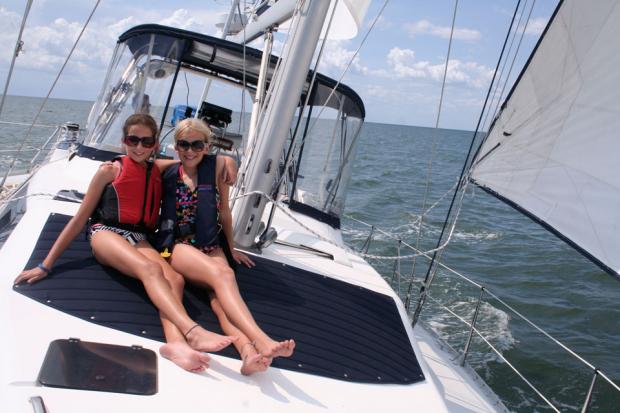
We all knew what the answer would be. Jon had often talked about the boyhood summers he’d spent sailing with his grandfather. He mentioned, more than once, plans to buy a boat for him and the kids to enjoy—someday, when he had the time. That June, Evan and Isabella enrolled in sailing camp. By August, they were tearing across the bay in Optimist dinghies, and Jon started browsing Craigslist for boats. With Rita’s passing, it’d become clear to us all how easily “someday” slips away.
The children’s sudden interest in sailing reinforced the idea of a kids-and-dads charter. It seemed too easy to pass up. One of the country’s oldest bareboat-charter companies, Southwest Florida Yachts, had a base in Burnt Store Marina, on Charlotte Harbor, just one hour south of Sarasota.
A center-cockpit Hunter Passage 42 pictured on the company website seemed like the perfect family escape pod.
The date of departure fell just a few days after Father’s Day—appropriate, and somewhat ominous, timing. If there were Olympic events for fathers, spending five days with a boatful of children would be the decathlon: shotput, pole vault, 1,500 meters, the whole deal—with a potato-sack race thrown in for good measure.
To the dads’ advantage, the Hunter had all the conveniences of a modern cruiser: air conditioning, genset, hot water, electric-flush toilets, and a full suite of electronics. Even the boat’s name, Fortuitous, seemed a good omen. To our disadvantage, the kids had immediately marked us as pushovers. On the first day, they quickly claimed the best real estate.
The girls settled into the owners suite, which had acres of locker space, its own head, and a sit-down shower-tub. The boys piled into the V-berth and spilled out their bags, crammed with puppets and stuffed animals. The antipodes of the girls’ tidy palace, the forward berth immediately descended into chaos. Behind the closed door, the dark cavern echoed with laughter and feral noises, as their cute, fuzzy puppets battled in the spotlight of the brass reading lamp.
Jon and I were left with the drop-down table berth, a prairie-like super-king-sized bed that was just big enough to avert our first skirmish. “Just keep your Red Sox cap on your side of the cabin,” was all that Jon, a staunch—and unrepentant—Yankees fan, said of our sleeping arrangement. With a Maginot Line drawn down the middle of the main saloon, we left the dock at 1400, right according to The Plan.
Four Islands for Five Kids
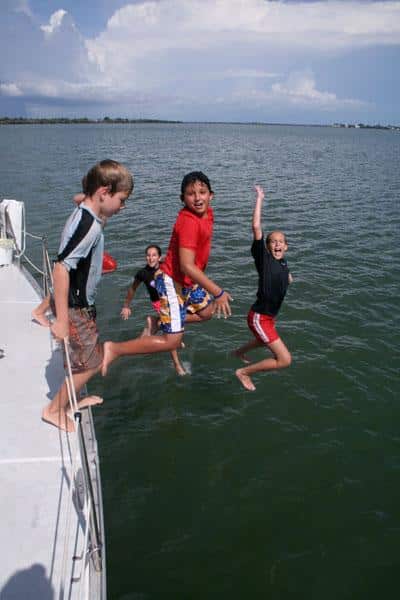
Southwest Florida Yachts’ two charter home bases, a northern base in Burnt Store Marina, near Punta Gorda, and the southern base in North Fort Myers, flank the region’s prime cruising grounds. The Charlotte Harbor estuary has dozens of islets, a maze-like mangrove coastline, and several long sand barrier islands with world-class beaches. A series of inlets, some too shallow or torturous to safely navigate, connect the protected sounds and bays with the Gulf waters beyond the barrier islands. There is no shortage of anchorages from which to choose, but with five energetic kids and only a few days to explore, a marina connection each night seemed to make the most sense. (The idea of an easy bailout in case things went horribly wrong also appealed to us.)
While the kids kept a running list of activities they wanted to pursue during the trip (sail, fish, snorkel, hunt for shells, and eat ice cream—to name a few), I looked forward to reliving some of the region’s history. Depending on what era I decided to drop into, I might find myself smoking Montesinos with Cuban exiles plotting to overthrow Fidel Castro, searching for El Dorado with Spanish conquistadores, or dining on sea snails with the Calusas, the statuesque shellfishing people who thrived in Charlotte Harbor for more than 5,000 years and then mysteriously disappeared. It was—and still is—a quirky corner of the planet, where the line between fact and fiction is as fleeting as the green flash.
Our first stop on the cruise was Boca Grande Marina, on Gasparilla Island. According to legend, a pirate by the name of José Gaspar used the island as a base for raiding merchant ships in the late 18th and early 19th centuries. His fortune, the legend says, is still hidden far inland along the Peace River, the winding, scenic waterway that flows into Charlotte Harbor.
The exciting and mostly fictional tale of plunder, a kidnapped princess, and buried treasure inspired our crew to adopt pirate names on our first morning on Gasparilla. Jake took the name Ol’ One Eye, based on his peeking tactic while playing Marco Polo. Ben, who acted out Pokémon battles on the foredeck at 0700, became Captain Thunderfoot. Kaylee, Isabella’s good friend and a last-minute addition to our crew, was dubbed the Fisher Queen for her talent with a rod and reel. Evan’s stupendous plunges into Charlotte Harbor earned him the name Captain Cannonball. But when it came to picking a name for Isabella, clearly the best sailor among our young crew, I was surprised when nothing came to mind.
“Let’s not rush,” I told her, as we tried a few names for fit. “The best pirate name is the one that finds you.”
She looked at me with sympathy, like one might regard a golden retriever who was too old to be playing fetch. “OK, let’s keep looking,” she said.
Gasparilla’s only town is Boca Grande, a small community with no traffic lights and a commercial center of four square blocks. The town began as a phosphate port, but a rising interest in sportfishing for tarpon in the early 1900s prompted wealthy snowbirds—Rockefellers, Du Ponts, and Vanderbilts among them—to build winter homes on the island. Unruffled by the NASCAR-like atmosphere that the tarpon tournaments bring each spring, the town retains the ambiance of a tropical Nantucket. As Kaylee concluded after some wide-eyed browsing in the local art galleries, “You need a bigger allowance to shop here.”
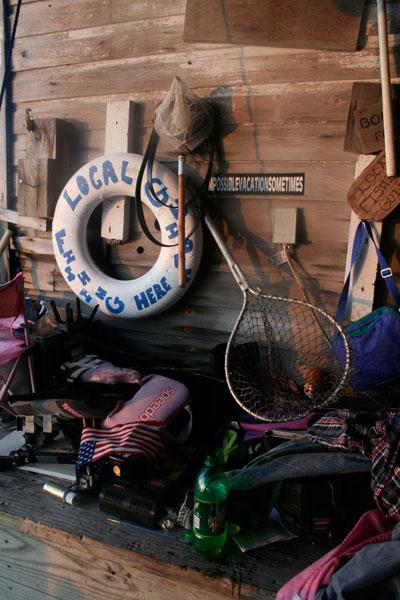
The golf cart is the favored form of local transportation, and our electric-powered island tour in a rented cart was a big hit with the kids. While the ice-cream shop was their favorite stop, mine was Whidden’s Marina, where I vainly tried to absorb the vibes from an antique fighting chair in which Ernest Hemingway had once sat. The varnished teak chair stood out among the dusty relics in a two-room maritime museum at the back of Whidden’s, a historic bait shop and marina that offers a fascinating, if not slightly eccentric, window into old Florida.
On our way back to the marina, we stopped at the corner of Fourth and Tarpon and marveled at a gem of a cottage, with scissor-cut Bermuda grass and a mango tree drooping under the weight of ripe fruit. A sunset-colored mango, as perfect as they come, dropped softly at Isabella’s feet. She scooped up the fruit and studied it—fascinated—and smiled in a way that reminded me of her mother. From then on, she became Mango Girl.
Living the High Life
After a night at anchor off idyllic Cayo Costa, a protected state park with nature trails, deserted beaches, and 27 camp sites, we headed south on the inland waterway to the South Seas Island Resort. Straddling the northern tip of Captiva Island, the expansive self-contained resort has a golf course, several restaurants, a small waterpark, two swimming pools, and a first-class marina—with first-class rates to go with it. The marina basin is also the home to Steve and Doris Colgate’s renowned Offshore Sailing School.
South Seas is no place for a family on a budget, but we’d made the mistake of letting the kids peek at the resort’s brochure. The glossy folio, more seductive than any Siren’s song, hooked them with just one word: “waterslide.”
Captain Thunderfoot, whose morning tap dance was fueled by a sugar-laced cereal that had somehow slipped aboard, found his bliss at a place called Scoop and Slice. He was convinced that the resort’s “family restaurant”—specializing in pizza, ice cream, and candy—was part of a national chain that I’d been hiding from him for years.
“Dad, what is Scoop and Slice most famous for? Its ice cream or its pizza?” he asked, between bites of cookie-dough ice cream. His words tumbled out like marbles, leaving me no chance to respond. “I think it’s the ice cream, definitely the ice cream, but the pizza is awesome, too.” Three messy bites later, he joined his crewmates at the water park, a shallow pool with two slides that barely contained the energy that Scoop and Slice had unleashed.
When the kids discovered Kawasaki jet-skis for rent at the resort’s watersports center, Jon and I were too exhausted to put up a fight.
Instead of taking long-awaited naps, we found ourselves sprinting across Pine Island Sound at 40 knots with our children screaming with delight and digging their nails into our backs.
The moment reminded me of times when the boys used to ride on my back and shout, “Giddyap!” as I crawled, too happy to feel the pain in my knees and spine, across the living-room floor.
Back to Nature
The next day, as we caught the ebb tide out of Redfish Pass into the Gulf of Mexico, my parental instincts returned from their weekend in Vegas, shocked—shocked!—at what they found. Horror of horrors, the kids were having a blast! This was not part of The Plan.
In our delusional scheming before the trip, Jon and I had imagined hours of fun—sure. But we also talked about creative ways to weave lessons about navigation, natural history, and biology into the trip. It didn’t seem like such a crazy idea at the time.
“Maybe next time,” I told Jon. With the stubble of a beard and circles under his eyes, Jon was looking ragged—like he needed a vacation. I wasn’t sure if he even heard me. “Cheeseburger in Paradise” was blasting through the cockpit speakers and the kids were singing along: “Big kosher pickle and a cold draft beer!” This, it seemed, would be the extent of their onboard curriculum. Bad daddies.
The steady southwest wind that had blown all week petered out after noon, so we motored the last few miles into Boca Grande Pass, past the historic lighthouse and museum on Gasparilla’s southern tip—another “to do” item that never got done. Within half an hour we were snug at the dock at what became my favorite stop on the trip, Useppa Island.
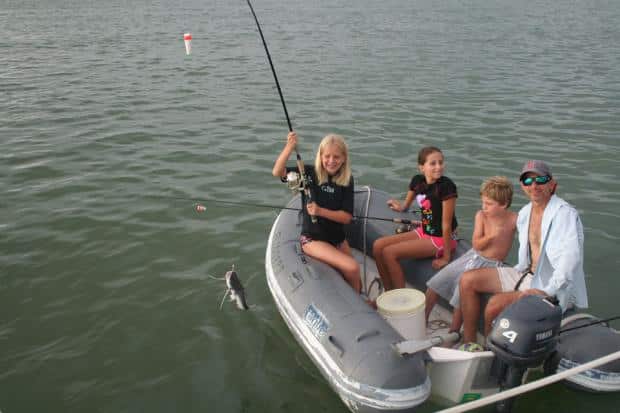
Trying to ease my guilt, I gave each child a sheet of notebook paper and asked them to list at least five facts that they’d learned on the trip. To my surprise, they liked the idea. The girls paired off against the boys, and the game was on.
Useppa Island was the place for a treasure hunt. For centuries, the island was an important center for Calusa culture, and the 50-foot-high shell midden stretching almost the entire length of the narrow, two-mile-long island left no doubt what was on the menu most nights.
A pathway through orchids and tropical fruit trees runs along the top of the shell ridge, and Key West-style vacation cottages line the path, each with a broad porch overlooking the water. At the highest point, a three-story Victorian hotel, the Collier Inn, rises next to a championship croquet court.
Built in the early 1900s, the inn is named after Florida pioneer Barron Collier, who used Useppa as a vacation retreat for his wealthy friends who liked to fish, dine, and whack golf balls around a rough-hewn course. The walls of the rustic Tarpon Bar, a classic varnished-pine and polished-brass watering hole overlooking the marina, are hung with portraits of these early snowbirds—dressed in their Sunday best—teeing off or battling with tarpon.
Today, the privately owned island is for members only, but guests can arrive on daytrips by boat, and nonmembers can arrange an introductory stay at the island cottages or inn.
Sipping a mojito poolside while the kids played, I tried to imagine what the place was like in 1961, when the resort—at that time abandoned—swarmed with C.I.A. agents and Cuban exiles training for the ill-fated Bay of Pigs invasion.
Although interested in the tales of Calusa warriors and C.I.A. spies, the kids were most impressed by Useppa’s wildlife. Manatees grazed in the surrounding sea-grass beds, osprey nested in the channel markers, and endangered gopher tortoises burrowed in the open fields between cottages. The treasure hunt had barely started when the Fisher Queen, Mango Girl, and Ol’ One Eye discovered another natural attraction: Tiny horseshoe crabs hatch each summer in the soft mud along the shore.
I collected the kids’ lists that evening as we enjoyed steaming plates of Jon’s famous spaghetti (one of the big advantages of having a true-blooded Italian on board, even if he is a Yankees fan). Their findings were impressive: the coordinates for the lead beacon to Boca Grande Pass, the arrangement of markers on the I.C.W., the names of 23 species of birds they’d seen on the trip, nine species of fish found in the local water, and a variety of mango trivia (from Mango Girl, of course). My parental instincts breathed a sigh of relief.
On the last night, Jon and I finally put a dent in the Flor de Caña and reflected upon the trip. We talked about sports, and kids, and music—and then tentatively about Rita. We both agreed she was probably happy to be watching our clumsy attempts at parenthood-under-sail from another place.
“She liked the idea of being outdoors,” Jon said, smiling, “as long as she could go home to her own bed.”
The next day, we returned to the Southwest Florida Yachts charter base, hopped in the car, and headed home. The fullness of our lives aboard Fortuitous receded, as if it had been a strange and funny dream. Our five-day charter didn’t deliver any miracle cure, but it brought—if only for a moment—a bit of peace and clarity.
That night, while tucking Captain Thunderfoot and Ol’ One Eye into their beds, I no longer worried about my big plans falling apart. I just wished time didn’t fly so fast. Peering out from beneath a mound of stuffed penguins, otters, owls, and bears, Ol’ One Eye seemed to read my mind. “Dad, can we do that again sometime?” he whispered.
I smiled, swelling with pride, and let the words sink in. “You bet.”
“Good,” he said, with a sigh. “But next time—let’s bring mom.”
Former Cruising World senior editor Darrell Nicholson is the editor of Practical Sailor magazine. At last check, Jon, Evan, and Isabella Lemole had three sailboats in their growing fleet: one Sunfish, one Optimist, and a Catalina Capri that was once owned by Jon’s grandfather.








